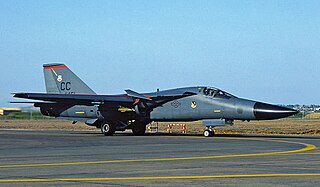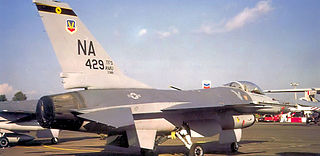
Nellis Air Force Base is a United States Air Force installation in southern Nevada. Nellis hosts air combat exercises such as Exercise Red Flag and close air support exercises such as Green Flag-West flown in "Military Operations Area (MOA) airspace", associated with the nearby Nevada Test and Training Range (NTTR). The base also has the Combined Air and Space Operations Center-Nellis.

Tactical Air Command (TAC) is an inactive United States Air Force organization. It was a Major Command of the United States Air Force, established on 21 March 1946 and headquartered at Langley Air Force Base, Virginia. It was inactivated on 1 June 1992 and its personnel and equipment absorbed by Air Combat Command (ACC).

Korat Royal Thai Air Force Base is a base of the Royal Thai Air Force (RTAF) in northeast Thailand, approximately 200 km (125 mi) northeast of Bangkok and about 4 km (2.5 mi) south of the centre of the city of Nakhon Ratchasima in the Nakhon Ratchasima Province, the largest province in Thailand.

George Air Force Base was a United States Air Force base located within the city limits, 8 miles northwest, of central Victorville, California, about 75 miles northeast of Los Angeles, California.

Takhli Royal Thai Air Force Base is a Royal Thai Air Force (RTAF) facility in central Thailand, approximately 144 miles (240 km) northwest of Bangkok in Takhli District, Nakhon Sawan Province.

The 366th Fighter Wing is a fighter wing of the United States Air Force Air Combat Command stationed at Mountain Home Air Force Base, Idaho.

The 355th Wing is a United States Air Force unit assigned to the Air Combat Command's Fifteenth Air Force. It is stationed at Davis–Monthan Air Force Base in Tucson, Arizona, where it operates the A-10 Thunderbolt II. The wing's mission is to provide close air support (CAS), air interdiction (AI), forward air control (FAC), combat search and rescue (CSAR), ground-based tactical air control, and airbase operations.

The 474th Air Expeditionary Group is a provisional United States Air Force unit assigned to Air Combat Command. It may be activated or inactivated at any time.

The 347th Rescue Wing is an inactive United States Air Force unit. It was last assigned to the Air Force Special Operations Command, stationed at Moody Air Force Base, Georgia. It was inactivated on 1 October 2006.

The 69th Fighter Squadron is a United States Air Force Reserve fighter squadron. It is assigned to the 944th Operations Group, stationed at Luke Air Force Base, Arizona.

The 7th Fighter Squadron is an active United States Air Force unit, assigned to the 1st Operations Group. It is stationed at Langley Air Force Base, Virginia.

The 389th Fighter Squadron is part of the 366th Fighter Wing at Mountain Home Air Force Base, Idaho. It operates McDonnell Douglas F-15E Strike Eagle aircraft conducting close air support.

The 391st Fighter Squadron is part of the 366th Fighter Wing at Mountain Home Air Force Base, Idaho. The squadron participated in combat missions in World War II and the Vietnam War, provided air defense in Korea and Japan from 1968 to 1971, and continues to provide tactical air command for the United States Air Force. It currently operates McDonnell Douglas F-15E Strike Eagle aircraft, conducting close air support missions.

The 428th Fighter Squadron is part of the 366th Fighter Wing at Mountain Home Air Force Base, Idaho. Currently, it operates F-15SG Strike Eagle aircraft conducting formal training missions to qualify Republic of Singapore Air Force crew in the F-15SG in a program titled Peace Carvin V.

The 832nd Air Division is an inactive United States Air Force organization. Its last assignment was with Tactical Air Command, (TAC) assigned to Twelfth Air Force at Luke Air Force Base, Arizona, where it was inactivated on 1 October 1991.

The 431st Test and Evaluation Squadron is an inactive United States Air Force unit. Its last assignment was with the Tactical Air Command 57th Fighter Wing stationed at Nellis Air Force Base, Nevada. It was inactivated on 30 June 1992.

The 474th Tactical Fighter Wing is an inactive United States Air Force unit. Its last assignment was at Nellis Air Force Base, Nevada, where it trained combat-ready aircrews and maintained a rapid-reaction capability to execute fighter attacks against enemy forces and facilities world-wide in time of crisis. A World War II predecessor unit, the 474th Fighter Group, was a Ninth Air Force combat unit of the Army Air Corps which fought in the European Theater. During its operational lifetime, the 474th Fighter Bomber Wing was engaged in combat operations during the Korean War and the 474th Tactical Fighter Wing was engaged in combat operations during the Vietnam War. Through its history, the 474th Wing flew the F-84G, F-86H, F-100D, F-111A, F-4D, and F-16A/B. The 474th Tactical Fighter Wing was inactivated on 30 September 1989.

The 430th Expeditionary Electronic Combat Squadron is an active United States Air Force unit. It is assigned to the 451st Expeditionary Operations Group.

The 481st Tactical Fighter Training Squadron is an inactive United States Air Force fighter squadron. Its last assignment was with the 27th Tactical Fighter Wing at Cannon Air Force Base, New Mexico, where it was inactivated on 8 July 1980.

The 478th Tactical Fighter Squadron is an inactive United States Air Force unit. It was last assigned to the 31st Tactical Fighter Wing and stationed at Homestead AFB, Florida.





























